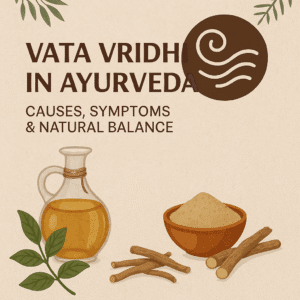In Ayurveda, the human body is governed by three doshas – Vata, Pitta, and Kapha. These doshas represent the energies of movement, transformation, and structure, respectively. Among these, Vata dosha is responsible for all bodily movements — including breathing, circulation, nerve impulses, and elimination.
But when Vata increases beyond its natural balance, it results in Vata Vridhi — a condition that disrupts physical and mental harmony.

🌀 What is Vata Vridhi?
Vata Vridhi means aggravation or increase of Vata dosha in the body. Vata is composed of the air and ether elements, making it light, dry, cold, rough, and mobile in nature. When this dosha increases unnaturally, it causes several disturbances in the body and mind.
⚠️ Causes of Vata Vridhi
Excessive fasting or irregular eating
Overconsumption of dry, cold, raw, or processed food
Stress, anxiety, overthinking
Lack of sleep
Exposure to cold and windy weather
Excessive physical activity or exercise
Traveling too often (especially air travel)
🔍 Symptoms of Vata Vridhi
Physical Symptoms:
Joint pain and stiffness
Dry skin and hair
Constipation, bloating, gas
Muscle cramps and tremors
Weight loss or poor appetite
Irregular menstrual cycles
Mental Symptoms:
Anxiety
Restlessness
Insomnia
Lack of focus or overactive mind
🌱 Ayurvedic Management of Vata Vridhi
1. Vata-Pacifying Diet
Eat warm, moist, and nourishing foods
Prefer ghee, sesame oil, milk, dates, rice, and cooked vegetables
Avoid dry, cold, raw, and processed foods
Include spices like ginger, cumin, ajwain, and cinnamon
Drink warm water or herbal teas
2. Herbs for Vata Balance
Ashwagandha – Strengthens nerves and reduces anxiety
Shatavari – Balances Vata and supports the reproductive system
Dashmool – Anti-inflammatory and calming
Bala – Restores vitality and nourishes tissues
Triphala – Supports digestion and elimination
3. Lifestyle & Daily Routine (Dinacharya)
Wake up early and follow a regular routine
Perform Abhyanga (self-massage) daily using warm sesame oil
Engage in gentle yoga and pranayama
Avoid overstimulation or excessive multitasking
Keep warm and avoid cold, windy environments
Go to bed before 10 PM
4. Panchakarma Therapies (for Severe Imbalance)
Basti (medicated enema) – The most effective therapy for Vata
Abhyanga & Swedana – Relieves stiffness and promotes circulation
Shirodhara – Calms the mind and balances nervous activity
Nasya – Clears the head and enhances focus
✅ Conclusion
Vata Vridhi is one of the most common imbalances in modern lifestyles — often caused by stress, irregular routines, and dry or processed foods. Ayurveda helps restore the natural rhythm of Vata through nourishing food, calming practices, and powerful herbs. By returning to balance, one can enjoy better digestion, sleep, clarity, and overall vitality.
🧘♀️ Balance Your Life with Ayurveda
Embrace warm foods, a stable routine, and gentle self-care to bring Vata into harmony. If symptoms persist, consult a qualified Ayurvedic doctor for a personalized treatment plan.


